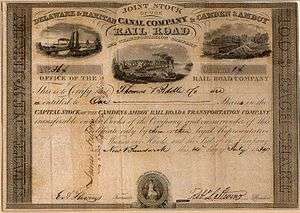Robert L. Stevens
| Robert Livingston Stevens | |
|---|---|
 | |
| Born |
October 18, 1787 Hoboken, New Jersey |
| Died |
April 20, 1856 (aged 68) Hoboken, New Jersey |
| Occupation | Steamship builder |
| Signature | |
|
| |
Colonel Robert Livingston Stevens (October 18, 1787 – April 20, 1856 Hoboken, New Jersey) was the son of Colonel John Stevens. In 1807, the father and son built the Phœnix, a steamship which became the first steamship to navigate the ocean successfully when she traveled from New York City to the Delaware River in 1809. The Phœnix could not operate in the harbor at New York City because Robert Fulton and his partner Robert Livingston (1746-1813), Minister to France, had obtained a monopoly there.
Robert Stevens applied the wave line, concave waterlines on a steamboat hull, in 1808. He invented other improvements to shipbuilding, and he invented a percussion shell, the rights to which he sold to the government. In 1842, he was commissioned by the government to build the first ironclad warship ever constructed, but he died without ever completing it.

Stevens was president of the Camden and Amboy Railroad (C&A) in the 1830s and 1840s. When the John Bull steam locomotive arrived on the C&A property, it was originally named Stevens in his honor. Although his father is occasionally credited with the invention of the flanged T rail for railways, Robert Stevens at 42 is considered to have been the inventor of the first all-iron rail construction of the Camden & Amboy. Before 1831, the rails of all previous American railroads were strap iron rails made of wood with a metal strap applied to the wood. One of the two men had traveled to England to purchase the new rails since there was no rolling mill in the United States that was capable of producing the rails. The flat bottomed rail profile is used by railways of every nation. It replaced the cast-iron edge rails that had been introduced in England in 1789, which were made without flanges; instead, flanges were placed on the wheels. (The flanged T rail was introduced in England in 1836 by engineer Charles B. Vignoles (1793-1875), therefore the term "Vignoles rails" came into use in Europe).
He was the brother of John Cox Stevens and Edwin Augustus Stevens.
References
- Today in Science History: October 18. Retrieved October 18, 2005.
- Iles, George (1912), Leading American Inventors, New York: Henry Holt and Company, pp. 28–34